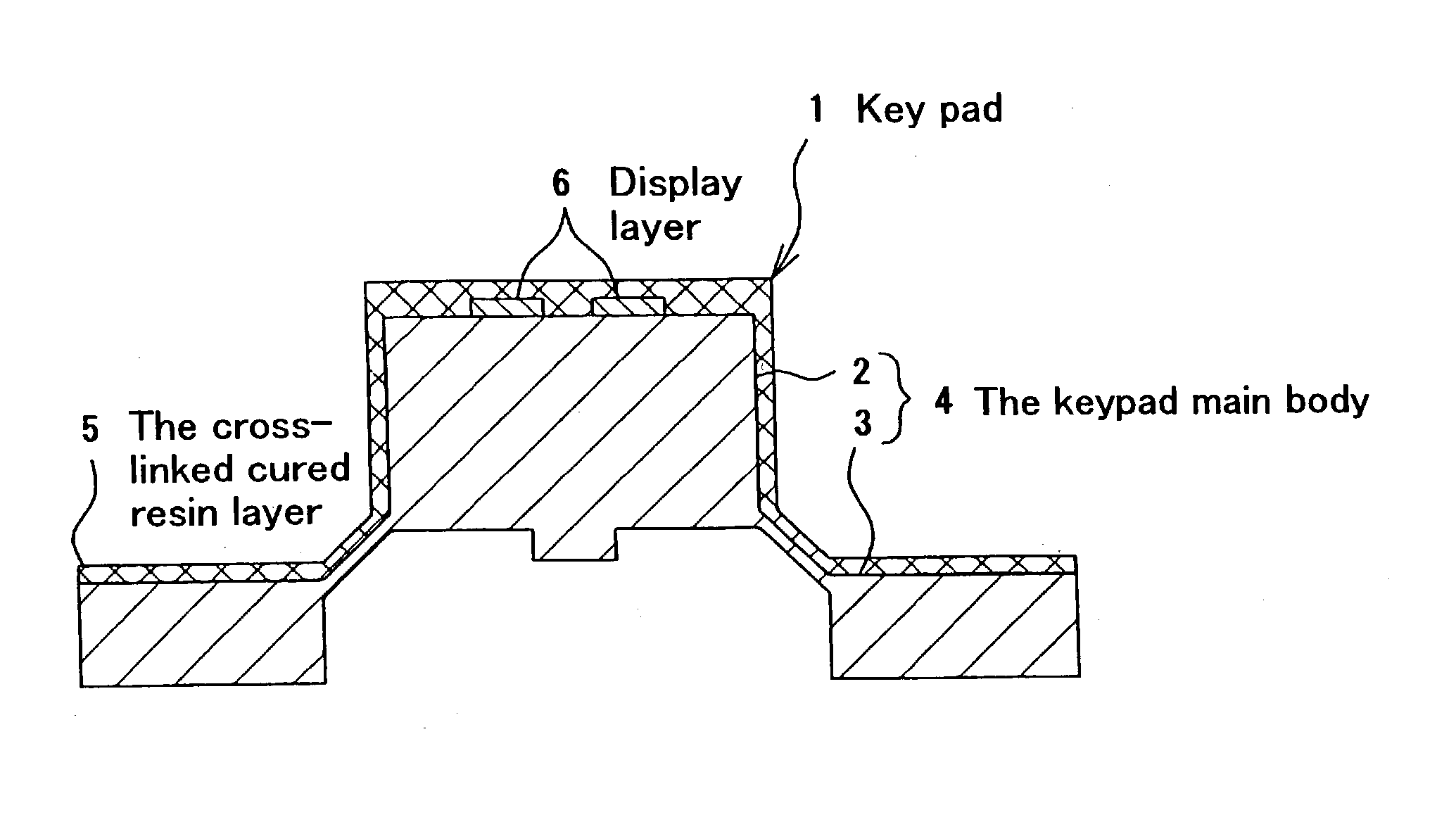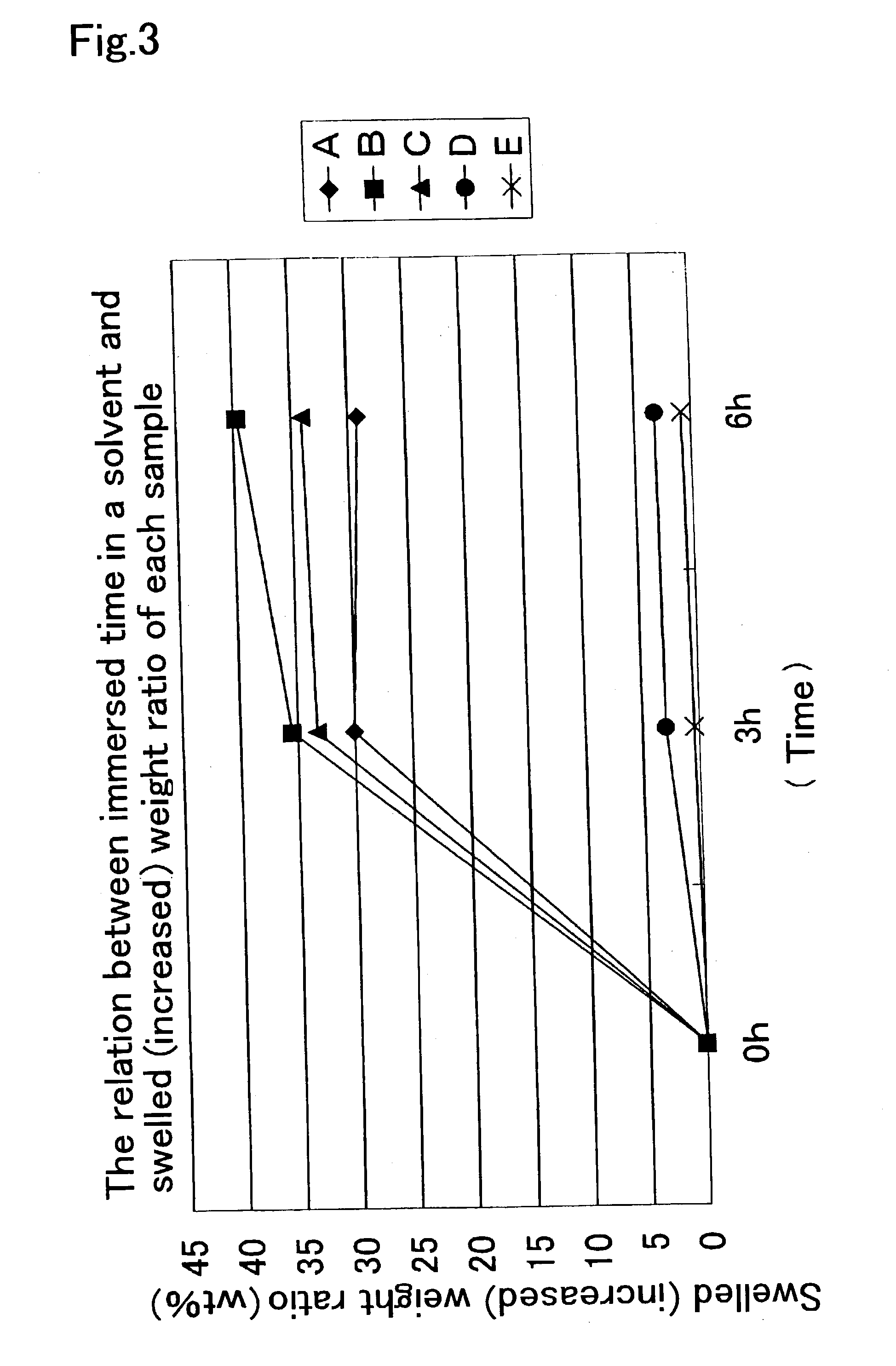Keypad and method of separating a crosslinked cured resin layer thereof
a crosslinked resin and keypad technology, applied in the field of keypads, can solve the problems of not meeting the needs of recycling, not easy to be recycled, and important, urgent, and social problems that remain unsolved
- Summary
- Abstract
- Description
- Claims
- Application Information
AI Technical Summary
Benefits of technology
Problems solved by technology
Method used
Image
Examples
example 1
[0048] The display layer 6 was formed by means of screen printing using a vinyl chloride based ink ("VIC," available from Seiko Advance Ltd.; room temperature drying type) on the top face of the key top portion 2 of the keypad main body 4 prepared using a styrene-based thermoplastic elastomer ("SEPTON CJ002," available from Kuraray Co., Ltd.). Furthermore, a blend prepared using urethane-modified polyols as a polyol compound and H.sub.6XDI as an isocyanate compound was set at NCO / OH=1.5 to 2.0 and to this were added a plasticizer, a flatting agent, an ultraviolet absorber, an antioxidant, an antifoaming agent, and a catalyst. The resulting mixture was viscosity-adjusted with a solvent for coating to yield a blend, which was applied on the surface of the keypad main body 4 by means of the spray method. Thereafter, the coat was heated at 80.degree. C. for 30 minutes to form the cross-linked cured resin layer 5 of an urethane-based resin. In this way, the recyclable keypad 1 with the k...
example 2
[0049] The display layer 6 was formed by means of screen printing using a vinyl chloride based ink ("VIC," available from Seiko Advance Ltd.; room temperature drying type) on the top face of the key top portion 2 of the keypad main body 4 prepared using a styrene-based thermoplastic elastomer (a blend with a weight ratio of styrene to epoxy modified styrene being 7:3) and the surface of the keypad main body 4 was treated by corona modification. Furthermore, a blend prepared using polyester-modified polyols as a polyol compound and an HDI biuret type as an isocyanate compound was set at NCO / OH=1.0 to 1.2 and to this were added a plasticizer, a flatting agent, an ultraviolet absorber, an antioxidant, an antifoaming agent, and a catalyst. The resulting mixture was viscosity-adjusted with a solvent for coating to yield a blend, which was applied on the surface of the keypad main body 4 by means of the spray method. Thereafter, the coat was heated at 80.degree. C. for 30 minutes to form ...
example 3
[0050] The display layer 6 was formed by means of screen printing using a PP based ink ("SPP," available from Seiko Advance Ltd.; room temperature drying type) on the top face of the key top portion 2 of the keypad main body 4 prepared using a olefin-based thermoplastic elastomer ("Santoprene," available from Advanced Elastomer Systems Japan Ltd.) and the surface of the keypad main body 4 was treated by corona modification. Furthermore, a blend prepared using polyester-modified polyols as a polyol compound and an IPDI as an isocyanate compound was set at NCO / OH=1.2 to 1.5 and to this were added a plasticizer, a flatting agent, an ultraviolet absorber, an antioxidant, an antifoaming agent, and a catalyst. The resulting mixture was viscosity-adjusted with a solvent for coating to yield a blend, which was applied on the surface of the keypad main body 4 by means of the PAD printing method. Thereafter, the coat was heated at 80.degree. C. for 30 minutes to form the cross-linked cured re...
PUM
| Property | Measurement | Unit |
|---|---|---|
| wavelengths | aaaaa | aaaaa |
| weight percent | aaaaa | aaaaa |
| pressure | aaaaa | aaaaa |
Abstract
Description
Claims
Application Information
 Login to view more
Login to view more - R&D Engineer
- R&D Manager
- IP Professional
- Industry Leading Data Capabilities
- Powerful AI technology
- Patent DNA Extraction
Browse by: Latest US Patents, China's latest patents, Technical Efficacy Thesaurus, Application Domain, Technology Topic.
© 2024 PatSnap. All rights reserved.Legal|Privacy policy|Modern Slavery Act Transparency Statement|Sitemap



